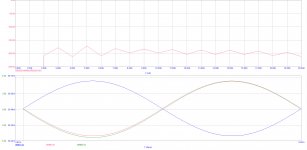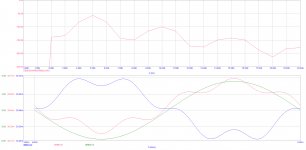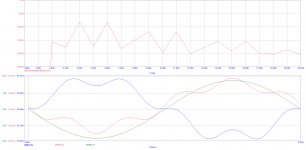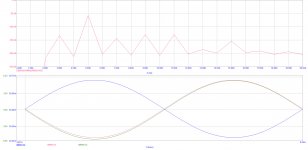since I order SANKEN's BjT power devices under
Sanken audio components at Profusion
no longer issues by repair on power amplifier are to observe.
Now I am looking for a supplier in the same kind, but from Toshiba parts, particularly for the often used and often faked 2SA1943/2SC5200 - go to the last images under
Sony N80es,E80es recapping.: Sony TA-N80es & TA- E80es recapping project
Sony N80es,E80es recapping.
I don't think, that e. g. the supplier under
2SA1943 2SC5200 TOSHIBA High Power Audio Transistor,x10 6921407396296 | eBay
exacltly know, if this parts really are genuine Toshiba parts.
Thanks for advices.
Last edited:
since I order SANKEN's BjT power devices under
Sanken audio components at Profusion
no longer issues by repair on power amplifier are to observe.
Now I am looking for a supplier in the same kind, but from Toshiba parts, particularly for the often used and often faked 2SA1943/2SC5200 - go to the last images under
Sony N80es,E80es recapping.: Sony TA-N80es & TA- E80es recapping project
Sony N80es,E80es recapping.
I don't think, that e. g. the supplier under
2SA1943 2SC5200 TOSHIBA High Power Audio Transistor,x10 6921407396296 | eBay
exacltly know, if this parts really are genuine Toshiba parts.
Thanks for advices.
Tief,
Try FJL4215 and FJL4315 from Mouser
FJL4315OTU ON Semiconductor / Fairchild | Mouser Australia
I would not buy any power semi's from ebay / China
cheers
T
Sanken's LAPT in MT200 outline discontinued
check out this threads:
SanKen ending production of most / all MT-200 transistors... | Page 2 | Audiokarma Home Audio Stereo Discussion Forums
Sanken MT-200 End of Life
The internal dies are also used on the MT100 outline.
But what about the thermal resistance ?
check out this threads:
SanKen ending production of most / all MT-200 transistors... | Page 2 | Audiokarma Home Audio Stereo Discussion Forums
Sanken MT-200 End of Life
The internal dies are also used on the MT100 outline.
But what about the thermal resistance ?
The internal dies are also used on the MT100 outline. But what about the thermal resistance ?
Just use 2 pairs of 2SC6145/2SA2223 instead of one pair of 2SC2922/2SC1216.
D'Agostino knows the solution

Sajti
Of course it is the solution for a new amplifier. The problem is repairing 80’s and 90’s amps. Anything you do will be a kluge. I suspect that respected repair folks have stockpiles that they’ll never let go of, except to do repairs for clients who pay good money for it. If I was legitimately in that business, I would have bought 200 NPN and PNP as soon as the EOL notices went out.
Hi, I stumbled upon the Mj21193/94 series and found out that they have the old metal package! Besides, I also know about the MJL4281/MJL4302 pair with much higher ft and flatter hfe curve. I have 2 questions.
1. Is the old TO-3 (apparently they changed to TO-204) metal package having any real advantage over the typical plastic package (TO-264)?
2. The hfe curve, graphically, is a bit misleading as the MJ21193/94 curve starts from 0.1A while the MJL4281/4302 curve start from 0.01A (i.e., the MJL4281/4302 curve therefore appear flatter). The value of hfe at 10A, for both pairs, hover around 20-30. Any comment on this?
Reference:
https://www.onsemi.com/pub/Collateral/MJ21193-D.PDF
https://www.onsemi.com/pub/Collateral/MJL4281A-D.PDF
1. Is the old TO-3 (apparently they changed to TO-204) metal package having any real advantage over the typical plastic package (TO-264)?
2. The hfe curve, graphically, is a bit misleading as the MJ21193/94 curve starts from 0.1A while the MJL4281/4302 curve start from 0.01A (i.e., the MJL4281/4302 curve therefore appear flatter). The value of hfe at 10A, for both pairs, hover around 20-30. Any comment on this?
Reference:
https://www.onsemi.com/pub/Collateral/MJ21193-D.PDF
https://www.onsemi.com/pub/Collateral/MJL4281A-D.PDF
The TO-3/TO-204's pro is the bigger contact area to the heatsink, whereas the plastic TO-247 is much easier to mount.
Surely you've seen that there are plastic TO-247 versions also, the MJW21193/94? The smaller contact area decreases their power dissipation ratings to 200 watts vs. 250 watts with the MJ's.
Best regards!
Surely you've seen that there are plastic TO-247 versions also, the MJW21193/94? The smaller contact area decreases their power dissipation ratings to 200 watts vs. 250 watts with the MJ's.
Best regards!
Hi, I stumbled upon the Mj21193/94 series and found out that they have the old metal package! Besides, I also know about the MJL4281/MJL4302 pair with much higher ft and flatter hfe curve. I have 2 questions.
1. Is the old TO-3 (apparently they changed to TO-204) metal package having any real advantage over the typical plastic package (TO-264)?
2. The hfe curve, graphically, is a bit misleading as the MJ21193/94 curve starts from 0.1A while the MJL4281/4302 curve start from 0.01A (i.e., the MJL4281/4302 curve therefore appear flatter). The value of hfe at 10A, for both pairs, hover around 20-30. Any comment on this?
Reference:
https://www.onsemi.com/pub/Collateral/MJ21193-D.PDF
https://www.onsemi.com/pub/Collateral/MJL4281A-D.PDF
As to 1, the real advantage is temperature cycling performance. The metal hermetic packages will hold up better - plastic will eventually fail. Things will delaminate. Moisture will ingress. Die attaches fail, and dies will crack - eventually. That being said, TO-92 packages that run hot last for decades. You don’t normally run stereo equipment over the kinds of temperature extremes that the metal packages were designed to withstand. Plastic packages are reliable *enough* for the application, at the ambient conditions normally encountered.
As to point 2 - check again vs. Vce. The 4281 types suffer from quasi-saturation. At 5 volts, hfe at 10 amps is about the same as the older types, but at 20 volts it improves a LOT and looks more like the 3281 curves. That’s just a consequence of making the breakdown voltage higher. The older types fall off at high current even at higher Vce. The curves at 5 and 20 volts for the 21194 is almost the same. It’s a little better at higher Vce, but not enough to pee your pants over.
check out this threads:Just use 2 pairs of 2SC6145/2SA2223 instead of one pair of 2SC2922/2SC1216.
D'Agostino knows the solution
Sajti
Dan D Agostino Interview..... Papa is one of the best !!!
post #49 under
Using Many Small Signal Transistors Paralleled in place of one output Transistor
shows a schematic of Krell's FPB300 - I think very similar.
interesting thread
Simulation of my bridge amp in Microcap12
Up: Harmonics
Down: Green is output voltage, red and blue are currents through VAS legs.
Lumba,
You have managed to summarize most of the misconceptions about negative feedback in one place. I guess you have not been reading all the info on this thread over the last few years.
In particular, you appear to be one of the many folks who have mis-interpreted and mis-applied Baxandall's results. You are not the only smart person who has done this.
Simulation of my bridge amp in Microcap12
Up: Harmonics
Down: Green is output voltage, red and blue are currents through VAS legs.
Attachments
NFB may change the distribution of EXISTING nonlinearties but it CAN NOT INVENT nonlinearities (either dynamical or static) not yet presents in circuit. This is another key point that Lumba Ogir miss... Of course!
My humple understanding:

Lets say the amp has pure K3 distortion due to the nonlinearity of the output stage.
With a 1 kHz test signal that is 3 kHz, which travels via feedback to the diff amp.
To compensate, the diff amp adds an amount of 3 kHz inverted to the signal.
So instead of only 1 kHz, the output stage is now dealing with 1 kHz and 3 kHz.
That 3 kHz should completely cancel the original K3 of the output stage.
However, it doesnt, instead there will be generated a new K3 which is now 9 kHz and a fraction of the original 3 kHz remains.
Now we have 1 kHz + harmonics 3 kHz + 9 kHz.
And there are more iterations resulting in even higher harmonics.
there´s not much I like about Douglas Self`s views, the theory of optimally biased class B is not an exception. Besides switching distortion, crossover distortion...
Output stages should be class A biased for normal listening power levels.
The blameless amplifiers necessarily have poor subjective quality and high distortion, even if it´s beyond measurement boundaries, no matter how many chapters are written in support of the opposite. The open-loop properties set the pertinent values, the rest is a bubble.
Disconnect the closed-loop and make your measurements, an amplifier is never better than its open-loop.
Maybe what he liked to say was... If the amplifier has class B crossover distortion in open loop and you add feedback... The sonic signature will not go away completely... It will remain, plus it will be altered to some extend by the higher harmonics added... So a classB amp will never ever become a classA amp.
The problem that I see, is that ClassB/AB has this distortion at low levels which is exactly the oppusite from what we have in nature.
Every instrument, voice, speaker, microphone and the ear will distort more at higher levels.
Thats what the brain is used to, so crossover distortion is unnatural to our hearing and we perceive it as fatigue and unpleasant.
Same problem with most multibit DACs at low level.
Similar issue with metal speaker cones, they may have some good properties but they have harsh resonances, you can try to flatten that resonant peak or put it a bit outside the used frequency band, but the sonic signature will never disappear.
Last edited:
- Home
- Amplifiers
- Solid State
- bipolar (BJT) transistor families for audio power output stages



